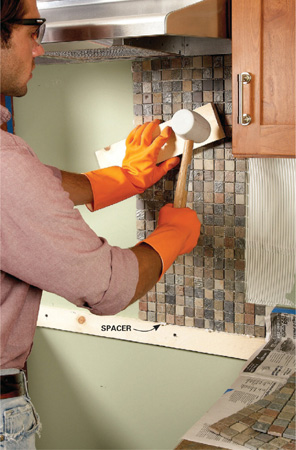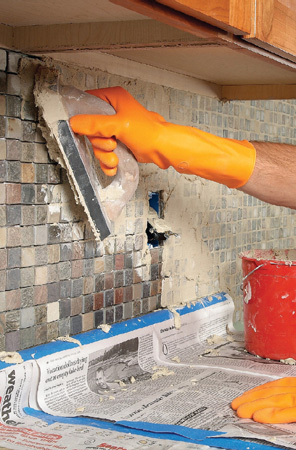
WHAT IT TAKES
Time: 1 weekend
Skill level: Intermediate

WHAT IT TAKES
Time: 1 weekend
Skill level: Intermediate
Nothing packs more style per square inch than mosaic tile. So if your kitchen’s got the blahs, give it a quick infusion of pizzazz with a tile backsplash. Because the small tiles are mounted on 12 x 12-in. sheets, installation is fast. You can install the tile on Saturday and then grout it on Sunday morning.
Professionals charge about $20 per sq. ft. for installing the tile (plus materials), so you’ll save $20 for every sheet you install yourself. The sheets cost $5 to more than $20 per sq. ft. at home centers and tile stores.
The total cost for this backsplash was about $200. The sheets of tile shown cost $10 apiece plus adhesive and grout. For an 8-ft. backsplash, you could save about $45 by using a less expensive tile.
Shown here are slate tiles, which sometimes crumble when you cut them. Other types of mosaic tile, especially ceramic tiles, are easier to cut.
Here you’ll learn how to install the tile sheets. You’ll need basic tile tools, available at home centers and tile stores, including a 3/16-in. trowel and a grout float. You’ll also need mastic adhesive, grout and grout sealer. You can rent a wet saw to cut the tiles.
Before installing the tile, clean up any grease splatters on the wall (mastic won’t adhere to grease). Wipe the stains with a sponge dipped in a mixture of water and mild dishwashing liquid. If you have a lot of stains or they won’t come off, wipe on a paint deglosser with a lint-free cloth or abrasive pad so the mastic will adhere. Deglosser is available at paint centers and home centers.
Then mask off the countertops and any upper cabinets that will have tile installed along the side. Leave a 1/4-in. gap between the wall and the tape for the tile (Photo 1). Cover the countertops with newspaper or a drop cloth.
Turn off power to the outlets in the wall and remove the cover plates. Make sure the power is off with a noncontact voltage detector (sold at home centers). Place outlet extenders (sold at home centers) in the outlet boxes. The National Electrical Code requires extenders when the boxes are more than 1/4 in. behind the wall surface. It’s easier to put in extenders now and cut tile to fit around them than to add them later if the tile opening isn’t big enough. Set the extenders in place as a guide for placing the tile. You’ll remove them later for grouting.
On the wall that backs your range, measure down from the top of the countertop backsplash a distance that’s equal to three or four full rows of tile (to avoid cutting the tile) and make a mark. Screw a scrap piece of wood (the ledger board) to the wall at the mark between the cabinets.
The area between the range and the vent hood is usually the largest space on the wall—and certainly the most seen by the cooks in the house—so it’ll serve as your starting point for installing the tile. Make a centerline on the wall halfway between the cabinets and under the vent hood (Photo 1). Measure from the centerline to the cabinets. If you’ll have to cut tile to fit, move the centerline slightly so you’ll only have to cut the mesh backing (at least on one side).
Using a 3/16-in. trowel, scoop some mastic adhesive out of the tub and put it on the wall (no technique involved here!). Spread the mastic along the centerline, cutting in along the ledger board, vent hood and upper cabinets (Photo 2). Then use broad strokes to fill in the middle. Hold the trowel at a 45-degree angle to the wall to spread the mastic thin—you should be able to see the layout lines where the points of the trowel touch the wall. Have a water bucket and sponge on hand to keep the trowel clean. Whenever the mastic starts to harden on the trowel, wipe it off with the wet sponge.
Place plastic tile spacers on the ledger board and countertop. This leaves a gap so the tiles don’t sit directly on the countertop (you’ll caulk the gap later).
Align the first tile sheet with the centerline, directly over the spacers. Press it onto the wall with your hand. If the sheet slides around and mastic comes through the joint lines, you’re applying the mastic too thick (remove the sheet, scrape off some mastic and retrowel). Scrape out any mastic in the joints with a utility knife.
Eyeball a 1/16-in. joint between sheets of tile (you don’t need spacers). After every two or three installed sheets, tap them into the mastic with a board and rubber mallet (Photo 3).
If tiles fall off the sheets, dab a little mastic on the back and stick them right back in place. The sheets aren’t perfectly square, so you may need to move individual tiles to keep joints lined up. Move the tiles with your fingers or by sticking a utility knife blade in the joint and turning the blade. If an entire sheet is crooked, place a grout float over the tile and move the sheet. You’ll have about 20 minutes after installing the tile to fine-tune it.
If you’re lucky, you can fit the tile sheets under upper cabinets and around outlets by cutting the mesh backing with a utility knife. If not, you’ll have to cut the tile with a wet saw. Nippers and grinders cause the slate tiles to shatter or crumble, although you can use these tools on ceramic tile.
Slice the backing to the nearest full row of tile, install the sheet around the outlet or next to the cabinet, then cut tiles with a wet saw to fill the gaps (Photo 4). Cut the tiles while they’re attached to the sheet. Individual tiles are too small to cut (the blade can send them flying!).
Let the tile sit for at least 30 minutes, then apply a grout sealer if you’re using natural stone (like slate) or unglazed quarry tile. The sealer keeps the grout from sticking to the tile (it’s not needed for nonporous tiles such as ceramic). Pour the sealer on a sponge, then wipe on just enough to dampen the tiles.
Wait 24 hours after installing the tile to add the grout. Use a premium grout that has a consistent color and resists stain. Since the backsplash will be subject to splatters and stains from cooking and food prep, spend the extra money for a premium grout. You can find it at home centers or tile stores. Use unsanded grout for tile with gaps of 1/8 in. or less, and sanded grout if the gaps are more than 1/8 in.
Mix the grout with water until it reaches mashed potato consistency, then put some on the wall with a grout float. Work the grout into the joints by moving the float diagonally over the tiles (Photo 5). Hold the grout float at a 45-degree angle to the tile. Scrape off excess grout with the float after the joints are filled.
Ten minutes after grouting, wipe the grout off the surface of the tiles with a damp sponge. If the grout pulls out of the joints, wait another 10 minutes for it to harden. Continually rinse the sponge in a bucket of water and wipe the tiles until they’re clean.
These slate tiles have a lot of crevices that retain grout. While most of the grout comes off the tiles with the wet sponge, some won’t. Most pro installers leave some grout in slate and other rough-surface tile—it’s just part of the deal with some types of natural stone. But if you want the tile completely clean, remove the grout from individual tiles with a toothbrush.
After cleaning the wall, use a utility knife to rake the grout out of the joints along the bottom of the backsplash and in the inside corners (Photo 6). These expansion joints allow the wall to move without cracking the grout.
Two hours after grouting, wipe the haze off the tiles with microfiber cloths. Then caulk the expansion joints with latex caulk. Use a colored caulk that closely matches the grout (available at tile stores).
After seven days, sponge on a grout sealer to protect the grout against stains.
That’s it! Now every time your family and friends gather in your kitchen, they’ll be impressed with your custom backsplash.

1 Mark a centerline between the upper cabinets so the tiles will be centered under the vent hood. Screw a ledger board to the wall to support the tile.

2 Spread a thin layer of mastic adhesive on the wall, starting at the centerline. Spread just enough adhesive for two or three sheets at a time so the adhesive doesn’t dry before you set the tile.

3 Tap the tile into the mastic with a wood scrap and a rubber mallet. Stand back, look at the tiles and straighten any crooked ones.

4 Cut tile sheets to the nearest full row to fit around outlets, then fill the gaps with tiles cut on a wet saw.

5 Force grout into the joints with a float. Scrape off excess grout by moving the float diagonally across the tile.

6 Rake the grout out of the joints at inside corners and along the bottom with a utility knife so you can fill them with caulk. Keep the dull side of the blade along the countertop.